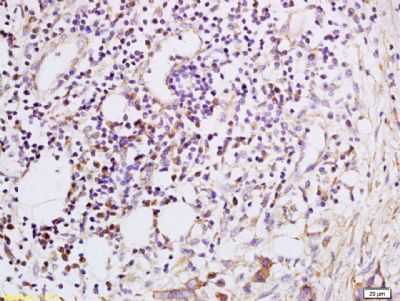
CXCR7,细胞表面趋化因子受体7抗体
产品名称: CXCR7,细胞表面趋化因子受体7抗体
英文名称: Anti-CXCR7 antibody
产品编号: HZ-2555R
产品价格: null
产品产地: 中国/美国
品牌商标: HZbscience
更新时间: 2023-08-17T10:24:20
使用范围: WB,ELISA,IHC-P,IHC-F,IF
- 联系人 : 鲍丽雯
- 地址 : 上海市闵行区闵北路88弄1-30号第22幢AQ136室
- 邮编 : 200612
- 所在区域 : 上海
- 电话 : 139****0749 点击查看
- 传真 : 点击查看
- 邮箱 : www.shzbio.net
- 二维码 : 点击查看
CXCR7,细胞表面趋化因子受体7抗体
产品编号HZ-2555R
英文名称CXCR7
中文名称细胞表面趋化因子受体7抗体
别 名GPCR RDC1; C X C chemokine receptor type 7; Chemokine C X C motif receptor 7; Chemokine orphan receptor 1; CMKOR1; CXC R7; CXCR 7; CXCR7; G protein coupled receptor 159; G protein coupled receptor RDC1 homolog; GPR159; RDC 1; RDC1; CXCR7_HUMAN.
说 明 书0.1ml 0.2ml
研究领域细胞生物 信号转导 细胞膜受体 G蛋白偶联受体
抗体来源Rabbit
克隆类型Polyclonal
交叉反应Human, Mouse, Rat, Chicken, Cow, Rabbit,
CXCR7,细胞表面趋化因子受体7抗体产品应用WB=1:100-500 IHC-P=1:100-500 IHC-F=1:100-500 IF=1:100-500 (石蜡切片需做抗原修复)
not yet tested in other applications.
optimal dilutions/concentrations should be determined by the end user.
分 子 量40kDa
细胞定位细胞浆 细胞膜 细胞外基质
性 状Lyophilized or Liquid
浓 度1mg/1ml
免 疫 原KLH conjugated synthetic peptide derived from human CXCR7
亚 型IgG
纯化方法affinity purified by Protein A
储 存 液0.01M TBS(pH7.4) with 1% BSA, 0.03% Proclin300 and 50% Glycerol.
保存条件Store at -20 °C for one year. Avoid repeated freeze/thaw cycles. The lyophilized antibody is stable at room temperature for at least one month and for greater than a year when kept at -20°C. When reconstituted in sterile pH 7.4 0.01M PBS or diluent of antibody the antibody is stable for at least two weeks at 2-4 °C.
CXCR7,细胞表面趋化因子受体7抗体PubMedPubMed
产品介绍background:
This gene encodes a member of the G-protein coupled receptor family. Although this protein was earlier thought to be a receptor for vasoactive intestinal peptide (VIP), it is now considered to be an orphan receptor, in that its endogenous ligand has not been identified. The protein is also a coreceptor for human immunodeficiency viruses (HIV). Translocations involving this gene and HMGA2 on chromosome 12 have been observed in lipomas. GCPR RDC1 is reported to be expressed in human cell lines and in cultured vascular endothelial cells and in rodent brain, kidney, lung, heart, spleen, pancreas, small intestine, blood, colon, and blood vessels. ESTs have been isolated from human normal bone marrow, brain, breast, cartilage, embryo, eye, fetal lung/testis/B-cell, heart, heart/melanocyte/uterus, kidney, liver/spleen, nerve, placenta, and umbilical libraries as well as several human cancer libraries.
Function:
Receptor for chemokines CXCL12/SDF1 and CXCL11. Does not elicit classical chemokine receptor signaling; chemokine binding does not activate G-protein-mediated signal transduction but instead induces beta-arrestin recruitment, leading to ligand internalization and activation of MAPK signaling pathway. Acts as a scavenger for CXCL12/SDF1 and, to a lesser extent, for CXCL11. Required for regulation of CXCR4 protein levels in migrating interneurons, thereby adapting their chemokine responsiveness. In glioma cells, transduces signals via MEK/ERK pathway, mediating resistance to apoptosis. Promotes cell growth and survival. Not involved in cell migration, adhesion or proliferation of normal haematopoietic progenitors but activated by CXCL11 in malignant hemapoietic cells, leading to phosphorylation of ERK1/2 (MAPK3/MAPK1) and enhanced cell adhesion and migration. Plays a regulatory role in CXCR4-mediated activation of cell surface integrins by CXCL12. Required for heart valve development. Acts as coreceptor with CXCR4 for a restricted number of HIV isolates.
Subunit:
Homodimer. Can form heterodimers with CXCR4; heterodimerization may regulate CXCR4 signaling activity.
CXCR7,细胞表面趋化因子受体7抗体Subcellular Location:
Cell membrane; Multi-pass membrane protein. Cytoplasm, perinuclear region. Early endosome. Recycling endosome. Note=Localized mainly in perinuclear regions in neurons and in early endosomes in T-lymphocytes and some other cell types, with very low levels detected on the cell surface. May spontaneously cycle between the plasma membrane and endosomal compartments.
Tissue Specificity:
Expressed in monocytes, basophils, B-cells, umbilical vein endothelial cells (HUVEC) and B-lymphoblastoid cells. Lower expression detected in CD4+ T-lymphocytes and natural killer cells. In the brain, detected in endothelial cells and capillaries, and in mature neurons of the frontal cortex and hippocampus. Expressed in tubular formation in the kidney. Highly expressed in astroglial tumor endothelial, microglial and glioma cells. Expressed at low levels in normal CD34+ progenitor cells, but at very high levels in several myeloid malignant cell lines. Expressed in breast carcinomas but not in normal breast tissue (at protein level).
Similarity:
Belongs to the G-protein coupled receptor 1 family.
Gene ID:
57007
Database links:
Entrez Gene: 57007 Human
Entrez Gene: 12778 Mouse
Entrez Gene: 84348 Rat
Omim: 610376 Human
SwissProt: P25106 Human
SwissProt: P56485 Mouse
SwissProt: O89039 Rat
Unigene: 471751 Human
Unigene: 6522 Mouse
Unigene: 12959 Rat
Important Note:
This product as supplied is intended for research use only, not for use in human, therapeutic or diagnostic applications.

